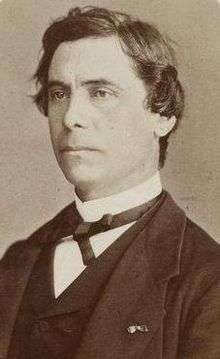Pierre Émile Levasseur
Pierre Émile Levasseur, 3rd Baron Levasseur (8 December 1828 – 10 July 1911), was a French economist, historian, Professor of geography, history and statistics in the Collège de France, at the Conservatoire national des arts et métiers and at the École Libre des Sciences Politiques,[1] known as the founders and promoters of the study of commercial geography.[2][3]

Life and work

Levasseur was born in Paris, France, as son of the jewelry manufacturer Pierre Antoine Levasseur. He was educated at the École Normale Supérieure in Paris.[4]
Levasseur began teaching in the lycée at Alençon in 1852, and in 1857 became professor of rhetoric at Besançon. He returned to Paris to become professor at the lycée Saint Louis. In 1868 he was chosen a member of the Academy of Moral and Political Sciences. In 1872 he was appointed professor of geography, history and statistics in the College de France, and subsequently became also professor at the Conservatoire des arts et métiers and at the École libre des sciences politiques, which later became known as the Institut d'Etudes Politiques de Paris.
Levasseur was president of the Société d'économie politique.[5] Levasseur was one of the founders of the study of commercial geography, and became a member of the Council of Public Instruction and honorary president of the French geographical society.
Levasseur was elected member of the Royal Swedish Academy of Sciences in 1894. He was elected a member of the American Antiquarian Society in 1905.[6]
Selected publications
His numerous writings include:
- La question de l'or (1858)
- Histoire des classes ouvrières en France depuis la conquête de Jules-César jusqu'à la Révolution (1859)
- Histoire des classes ouvrières en France depuis la Révolution jusqu'à nos jours (1867)
- L'Étude et l'enseignement de la géographie (1871)
- La Population française (1889–1892)
- L'Agriculture aux États-Unis (1894)
- L'Enseignement primaire dans les pays civilisés (1897)
- L'Ouvrier américain (1898)
- Questions ouvrières et industrielles sous la Troisième République (1907)
- Histoire des classes ouvrières et de l'industrie en France de 1789 à 1870 (1903–1904)
- Grand Atlas de géographie physique et politique (1890–1894).
References
- Wilhelm Bernsdorf, Horst Knospe. International Lexicon of Sociology. 1980, p. 245.
- Collier's Encyclopedia: With Bibliography and Index, Vol 12, 1958. p. 311.
- Robert Leroux (2012). French Liberalism in the 19th Century: An Anthology. p. 244
- Encyclopedia Americana, Vol. 17, 1965, p. 316
- ÉMILE LEVASSEUR, Académie des Sciences Morales et Politiques, retrieved 2017-08-18
- American Antiquarian Society Members Directory
- Attribution
![]()
External links
| Wikimedia Commons has media related to Pierre Émile Levasseur. |
- (in French) Emile Levasseur at bnf.fr